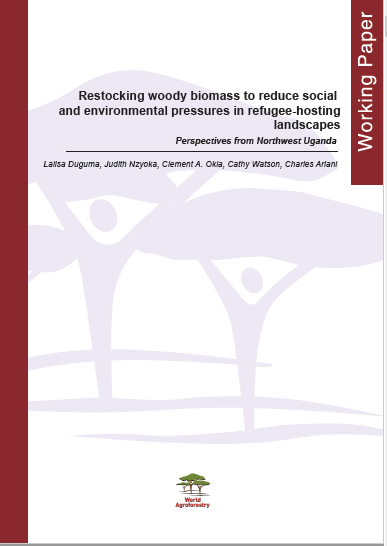This report on the situation in Northwest Uganda, published by the World Agroforestry, examines the quantity and composition of biomass in the two refugee settlements and the buffer zone around them. It is based on an inventory that counted and identified every seedling and sapling and all standing trees on 234 circular plots and recorded their diameter at breast height (DBH), bole height, total height and crown diameter.
 It may sound elaborate to a lay person but with that information we can predict the quantity of woody biomass available and how long it can support community needs, said Clement Okia of ICRAF Uganda. It also gives guidance on investment needed to undertake restoration work.
It may sound elaborate to a lay person but with that information we can predict the quantity of woody biomass available and how long it can support community needs, said Clement Okia of ICRAF Uganda. It also gives guidance on investment needed to undertake restoration work.
Shrubs and stumps were also captured.
Identifying stumps is usually difficult but it was done with support from local forestry experts and the community, the authors note.
Findings include considerable biodiversity in the form of 81 tree species. But extraction pressure is intense. Most stumps were of large trees (DBH greater than 20 cm), indicating a decline in mature trees. This is worrying as large trees offer the most ecosystem services and are the ‘mother trees that provide genetically diverse seeds.
The study sought to answer the question: how much woody above-ground biomass is available for refugees and hosts? After calculations that factored in calorific value, it was found to reach a total of around 1,423,345 tons across the two settlements and buffer zone.
This sounds considerable but, given the needs, the woody biomass within the two refugee settlements could be exhausted within four years, a terrifying prospect. Utilizing the biomass outside the refugee settlements in the buffer zone would extend this time period but create conflict with local communities.
The report concludes that urgent measures are needed to stem the loss of biomass and diverse species. It recommends several actions.
- Perform tree inventories prior to plot allocation so that appropriate options for management can be put in place by and for the refugees.
- Create a system for tree planting, growing, regeneration and protection with officials, refugee and host communities, support agencies and others.
- Achieve a consensus on priority areas to plant, regenerate and protect.
- Agree on how to control burning of biomass and contain livestock.
- Note endangered tree species and build awareness of them.